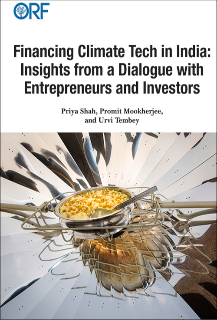
“This time it is truly different”
Financial market punditry revels in truisms. One of them is the old chestnut about “this time its different”. There is an inherent, somewhat justified skepticism about this hypothesis, borne out by decades (sometimes centuries) of mean reversion. Most things, certainly financial market variables, tend to over time revert to an estimated mean (or average). However, this time it does seem rather different, at least different from what the generations living today have experienced.
Covid19 isn’t a one-off
The best-case scenario is the development of a vaccine or therapeutic soon enough. However, till a scalable solution is found, not only will large swathes of businesses—restaurants, hotels, airlines—be wiped off, basic human behavior that underpins business and commerce will also change. As Prof. Kaushik Basu says, “
no economist writes down ‘can talk’ as an assumption. It is regarded as a given”. Being able to talk, walk up to the desk, argue and form relationships are core to how businesses are run – take that away, and mankind needs a different paradigm to set the rules of business.
The world is getting (economically) nastier
Social media tends to exaggerate political soundbytes. Despite all the noise on conflicts around the world (US-China, India-China, Afghanistan, Pakistan, Middle East), the world is a relatively peaceful place in terms of physical security. Warzones are few, hot conflicts engendering loss of civilian lives and properties are even fewer in the context of the 20
th century history. There is however a distinct turn in economic behavior. The post-World War II journey towards greater integration of trade, openness to immigration, expansion of the global commons for business and commerce is being reversed. Protectionism has become a politically respected word in economic policy lexicon, and for good or for worse there is increasing resonance around the Thomas Piketty-style inequality stories.
India – caught out in the wrong side of time?
India’s growth was slowing down in a secular trend even before the advent of COVID-19 and lockdown-related shocks. The slowdown has exacerbated the twin balance-sheet issue confronting India. This comprises stretched corporate leverage and concomitantly stressed bank (and Non Banking Financial Companies, or NBFC) balance sheets. Consequently, the financial system—which is the primary conduit and increasingly the primary source of intervention in the real economy—is far too weak to effectively play a big part. 2020 was supposed to be a break-out year—aided by some global tailwinds and base effect, there was expectations of a bounce-back in growth. Unfortunately, COVID-19 put paid to those calculations. In short, India is faced with a double-jeopardy scenario—a weakening base of growth and a weakened set of financial institutions that are unable to front-load risk-taking. Add to it the unwillingness (or the inability) of the government to print money to take us out of this slowdown.
The silver linings
In this somewhat depressing scenario, there are some very important silver linings. They will be crucial for India to leverage while crafting a break-out strategy. For starters, the Foreign Exchange (Forex) constraint, one of India’s eternal constraints in economic policymaking, is largely absent. This is quite remarkable, given the worsening of external accounts of several Emerging Markets (EM) in the current crisis. Thanks to robust foreign equity flows, lower Current Account Deficit (CAD) and aggressive dollar buying by Reserve Bank of India (RBI),
India’s Forex reserves today top US$500 billion. This providese a big policy cushion—one that hasusually not been available to India during previous crises.
Second, nearly the entire public debt is financed via local savings, making it India’s unique strength for several decades now. There is no dependence, barring for tactical liquidity purposes in very small doses, on external foreign investment to fund India’s fiscal deficit (fisc). While the conventional commentary—including by Credit Rating Agencies (CRA)—lament India’s high levels of sovereign debt, the fact is that the entire debt is financed locally. In other words, India’s public debt is financed by Indian Rupee (INR) capital, ie, in a currency which Government of India, the borrower, also enjoys a seigniorage (or power to print the currency) in.
Policy Choices
Government spending
While policy impulses, simplified tax regimes and all that passes off as “reforms” can play a part, the real heavy lifting in a post-COVID-19 strategy has to be government spending. With private discretionary consumption likely to remain muted for some time, private corporate sector investment would likely take longer, and global trade and commerce remaining both slow and mired in the new protectionist debates—government spend is the only viable game in town. Its not a surprise therefore to see the level of fiscal stimuli announced in several countries around the world, going up to
as much as 10-20% of gross domestic product (GDP). The Indian fiscal intervention, till now, has been small and cautious. But there have been promises of more as the lockdown is lifted. It is really not an option, so the question around a bigger fiscal push has to be a question of
when rather than
if.
Choice of financing
For the government to spend more, a viable financing plan is a
sine qua non. Globally, developed countries are financing enhanced fisc via money-printing programmes (also called Quantitative Easing, or QE). India has the same option too, but (till now) has been strangely recalcitrant about exercising it. There is a fear that printing money will cause a run on the currency, with all its attendant issues. But given that India funds all its public debt via local savings (as discussed above), it is a risk that exists more in theory than in realms of plausible reality. Unless the government spending program sends the CAD sky-rocketing, there is very little risk to a wholesale devaluation of the currency. However, it is a fact that the government has held back on exercising this option.
The other option to fund an expanded fisc, with a fair assumption that tax revenues are going to fall short, is via an aggressive asset sales program. A fire sale of state assets is not usually a great strategy for managing taxpayer-owned assets, but if the expenditure is focused on creating new infrastructure assets, it would only mean swapping one type of public assets with another. In other words, if proceeds from (the planned) LIC stake sale are used to create (say) 5 new hospitals, it isn’t really a dilution of taxpayer-ownership of economy, but merely swapping LIC shares for hospital ownership.
Maybe a variant of the Hobson’s choice, but a choice that needs to be exercised.
Focus on inflation
For a very long time, inflation has been a primary concern for economic policymaking. This is driven by the importance of inflation in our political economy discourse. In recent times, India has sought to embrace a “low inflation” mantra as some sort of axiomatic truism. It climaxed into the Inflation Targeting law that formally gave the RBI an inflation target as its primary objective in policymaking. While it meant that India has seen record low average inflation rates for the last few years, it has also disturbed several other economic outcomes. Lower inflation has meant lower nominal GDP growth; this is the reason why a 6-7% growth in recent times didn’t seem to “feel” like the 6-7% growth we saw earlier. Sans a higher nominal GDP growth, incomes don’t grow as fast, demand doesn’t go up as fast, tax revenues don’t grow as fast. More importantly a higher inflation allows the government to inflate away debt faster and creates greater headroom for more debt to be taken for higher growth in the future.
Today, when the primary issue confronting us is a massive demand destruction, inflation is bound to trend lower. This could have the effect of a disastrous spiral as government is unable to mop up enough revenues, and also unable to raise more debt as underlying GDP nominal growth remains weak.
A variety of policy tools—from direct income support to dilution of Inflation Targeting mandate to RBI – need to be used to ensure that India’s inflation remains solidly positive.
It isn’t the beginning of the end, or the end of the beginning, its merely the end of an era
An era is fading away. An era of expanding global commons, free trade and global prosperity. The new era might well end up being a more dog-eat-dog world. But India’s opportunities remain immense – not only because of its oft-repeated strengths of young population and big middle class. Our silver linings are bright, and COVID-19 has not destroyed our physical infrastructure. But government policymaking needs to be quick, adaptive and decisive – if we are to escape a prolonged growth funk, something that India can ill-afford.
The views expressed above belong to the author(s). ORF research and analyses now available on Telegram! Click here to access our curated content — blogs, longforms and interviews.



 “This time it is truly different”
Financial market punditry revels in truisms. One of them is the old chestnut about “this time its different”. There is an inherent, somewhat justified skepticism about this hypothesis, borne out by decades (sometimes centuries) of mean reversion. Most things, certainly financial market variables, tend to over time revert to an estimated mean (or average). However, this time it does seem rather different, at least different from what the generations living today have experienced.
“This time it is truly different”
Financial market punditry revels in truisms. One of them is the old chestnut about “this time its different”. There is an inherent, somewhat justified skepticism about this hypothesis, borne out by decades (sometimes centuries) of mean reversion. Most things, certainly financial market variables, tend to over time revert to an estimated mean (or average). However, this time it does seem rather different, at least different from what the generations living today have experienced.
 PREV
PREV

